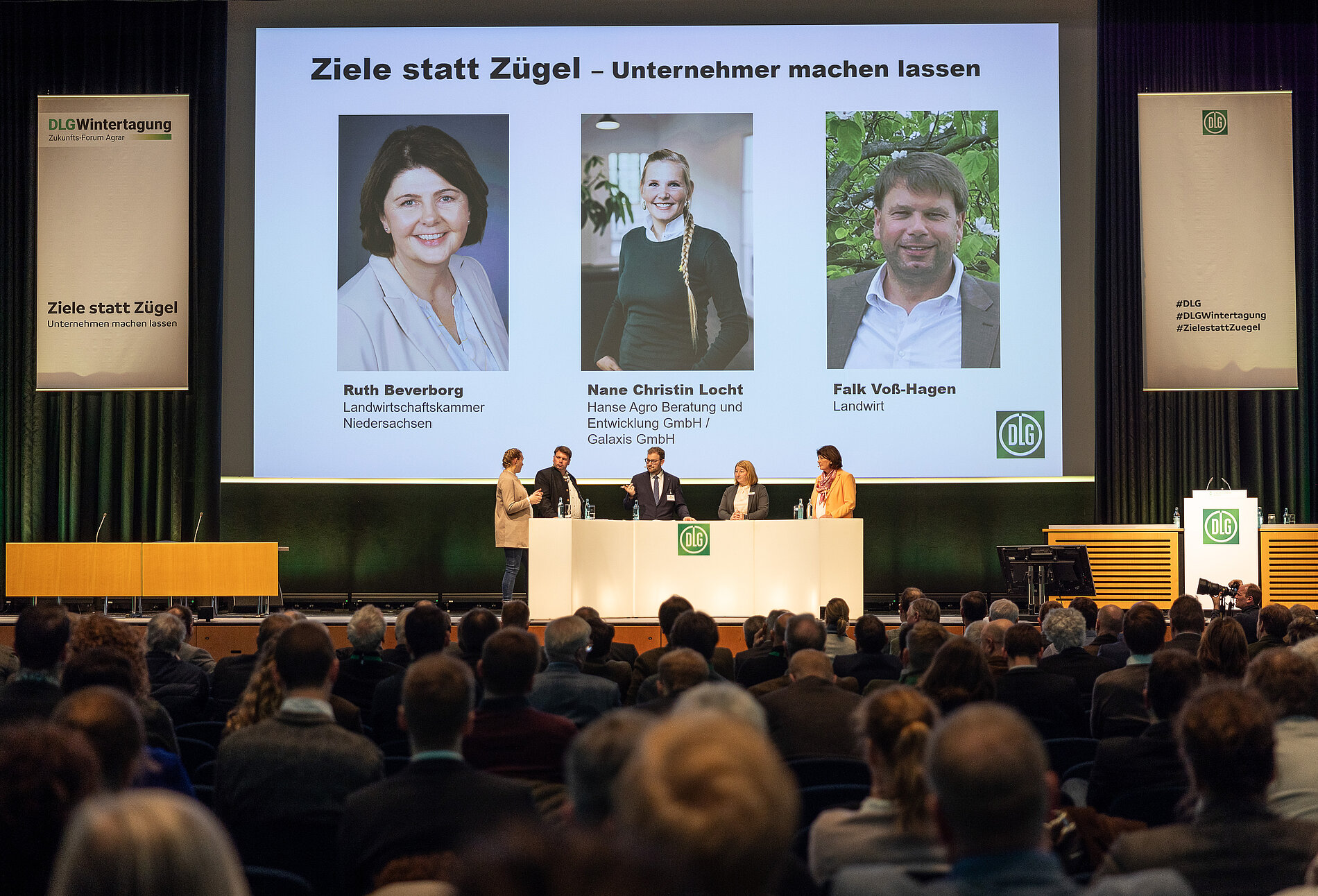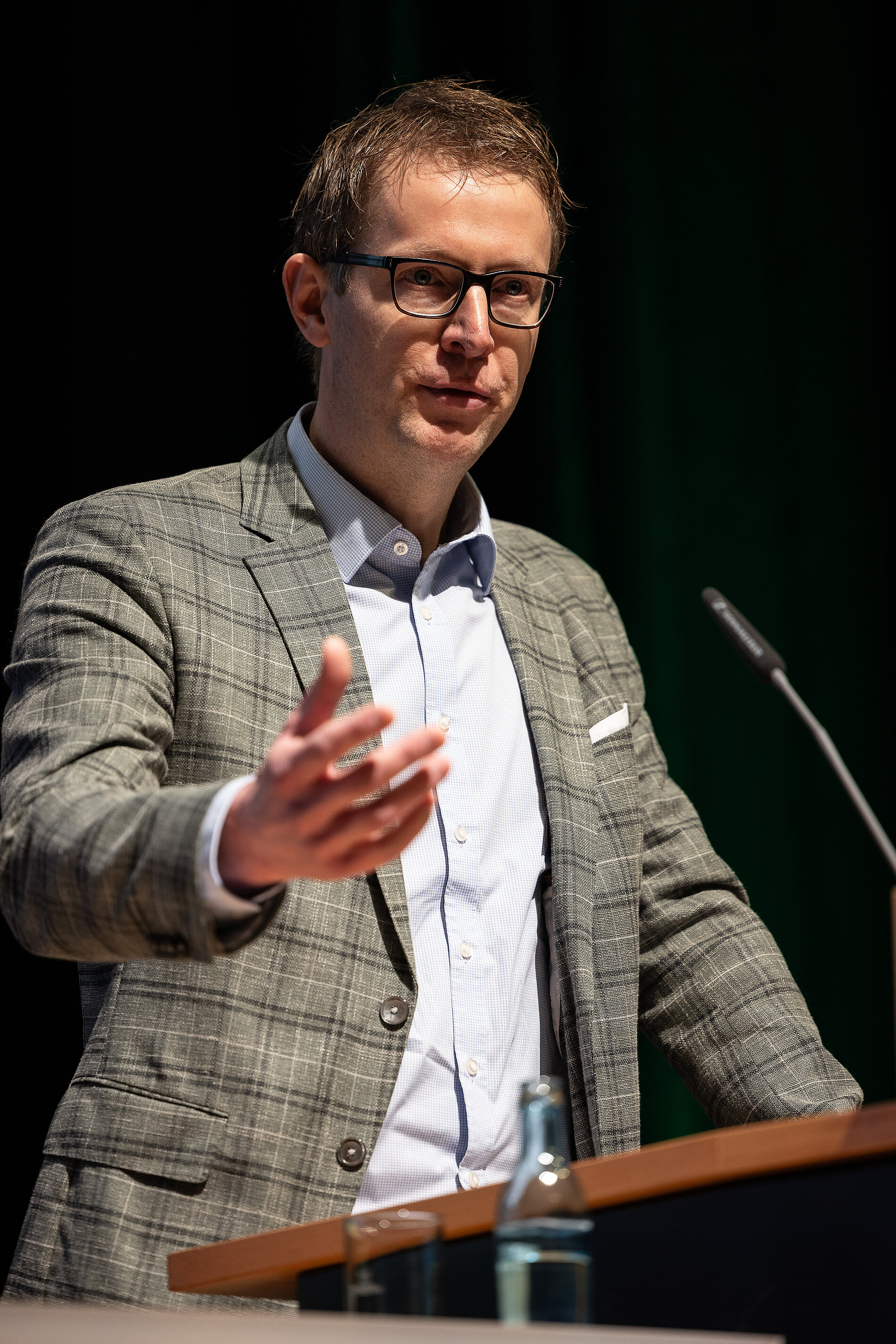DLG Wintertagung 2024: Digital interfaces instead of multiple documentation
Practitioners make proposals for a more efficient system of agricultural policy
If it takes seven years to obtain a permit for building a new stable, documentation is done on paper and, in the worst case, multiple times, then there is a need for change. Practitioners outlined the pain points of current regulations and what could be done to remedy them in the plenary session of the DLG Winter Conference. The various impulse forums dealt with tangible, practical issues, such as the reduction of methane emissions in dairy farming.
"We are looking for a middle way between boundless freedom and excessive regulation," said Siv Biada, Head of the DLG's International Crop Production Center, summing up the basic requirements for a sustainable agricultural policy system. At the beginning of the plenary session on Wednesday at the DLG Wintertagung 2024, DLG’s annual Winter Conference, DLG President Hubertus Paetow had previously emphasized that bureaucracy and control systems are fundamentally legitimate concerns of a democratic system. However, "poorly managed political decisions" made it necessary to make processes more efficient. The DLG could and should contribute to this and make concrete suggestions for improvement. In keeping with this, the DLG winter conference was held under the motto "Goals instead of reins - let companies do it".
Inconsistent regulations unsettle practitioners
Agricultural advisors Ruth Beverborg from the Lower Saxony Chamber of Agriculture and Nane Christin Locht, Hanse Agro Beratung und Entwicklung and Galaxis GmbH, as well as farmer Falk Voss-Hagen, described how regulations and bureaucracy affect day-to-day operations. Ruth Beverborg criticized, for example, inconsistent greening regulations for set-aside areas within the GAEC standards from her consulting practice, which caused uncertainty among farmers.
Nane Christin Locht reported from her own experience that determining fertilizer requirements can also be helpful for realistic planning of requirements on farms. However, she also pointed out that further control steps such as fertilizer documentation and material flow balances would result in more or less identical processes being documented several times.
Seven years and 56 folders for a building permit
Farmer and pig producer Falk Voss-Hagen reported that, in his experience, approval procedures for barn buildings take around seven years and fill 56 folders.
The practitioners did not fundamentally question the need for documentation and controls, but unanimously saw the need to improve the current system. Falk Voß-Hagen, for example, proposed a secure data room in which all documents required for a building permit process could be collected, made accessible via interfaces to all persons involved, from the farmer to the architect to the approving authority, and approval processes could also be carried out directly in digital form via electronic signature procedures.
Constructive suggestions needed
During the plenary session at the winter conference, Locht, Beverborg and Voss-Hagen exemplified what the DLG has set itself for the future: To constructively develop concrete suggestions for improvement and contribute them to the discourse on reshaping the agricultural policy system. "The state and the administration cannot take this into their own hands. It is up to us to develop proposals for improvement for deregulation and the reduction of bureaucracy," said DLG Vice President Philipp Schulze-Esking.
Meanwhile, Prof. Karl Heinz Paqué, Chairman of the Friedrich Naumann Foundation for Freedom, spoke out in favor of a radical reduction in bureaucratic requirements at the DLG Winter Conference in Leipzig. He emphasized that openness to innovation and technical progress would only work with an urgently needed reduction in bureaucracy.
However, in order to make the process of change future-proof in the interests of agriculture, more is needed than just a reduction in bureaucracy and good technical concepts. How those affected perceive change always depends on "framing". Prof. Ewald Frie emphasized this during the impulse forum "Experiencing change - shaping change: What do upheavals in agriculture mean for those affected?" now at the DLG Winter Conference 2024 in Leipzig. Framing, i.e. the way in which those affected communicate about reality, therefore determines whether change is experienced as something positive or negative.
In his award-winning non-fiction book " One farm and eleven siblings: The silent farewell to farm life ", Frie, Professor for Modern History at the University of Tübingen, describes the effects of change in agriculture using the example of his family of origin and their family farm in North Rhine-Westphalia. He focuses on the period between the post-war period and the 1980s. Frie interviewed his siblings for his book. The siblings told "success stories", explained Frie during the winter conference - regardless of whether they had taken over the business, sought a career in agriculture or followed a professional path outside the agricultural sector.
"Dying farms" and "rural exodus" have negative connotations
Terms that describe the changes in agriculture sometimes have negative connotations, observed Frie. "Dying farms" or "rural exodus" would accordingly create a "negative framing". The historian and author made it clear that those who choose a life outside of rural areas are not committing a rural exodus, they are simply opting for a different alternative. Dr. Heike Müller from the rural women organisation of Mecklenburg-Western Pomerania, also stated that leaving a farm could be a sensible alternative among several options from an economic point of view. However, terms such as "farm death" would cast a negative light on such a decision.
Coalitions in demand in the countryside
With regard to the current farmers' protests, historian Frie noted that the structural change in agriculture had led to rural society being "de-peasantized". The current farmers' protests are not protests "of the countryside against the city", Frie clarified. Farmers in rural areas also have to deal with everyday conflicts, for example "with those who jog past the fields while working." One task for the future is therefore to "create coalitions and connecting spaces in the countryside."
In addition to fundamental discussions about realignments in the agricultural policy system, the impulse forums at the DLG winter conference also addressed very practical issues. Climate protection, for example, was the focus of the impulse forum on methane in dairy cows, which was organized by the DLG Working Group for Feed and Feeding and the DLG Committee for Milk Production and Cattle Husbandry.
Climate change: strategies for dairy farmers
Dairy cows are directly involved in climate change through methane emissions, but are also affected by losses in feed production and heat stress. At the same time, there is an opportunity for an objective discussion on how grassland can be used with little food competition and how the supply of meat and dairy products to humans can be ensured.
Essentially, an improvement in feed energy efficiency should be mentioned here, i.e. in order to achieve low methane production, it is necessary to feed with a high quality of coarse feed in line with demand, ruminants and precision.
Proportion of milk fatty acids as a guide
Dr. Wolfram Richardt from LKS (Landwirtschaftliche Kommunikations- und Servicegesellschaft mbH, an agricultural communications and service company) in Lichtenwalde explained that knowledge about measuring methane emissions dates back to around 1880 and that there are a variety of different measuring devices for scientific applications. On the farms, the composition of the milk and in particular the proportion of milk fatty acids could be an interesting starting point, because these correlate with methane production and emissions. The advantage here: The values are usually determined in the milk performance test or at least at tank level on a daily basis in the dairy. Milk spectra could serve as another alternative, but these are only suitable for larger groups of animals rather than for evaluating individual animals.
Prof. Dr. Hubert Spiekers from the Bavarian State Institute for Agriculture (LfL) in Grub examined the question of how the climate impact of dairy cows could be reduced overall. In his presentation, he referred to both CO2 and nitrous oxide (N2O) with a particularly high conversion factor to CO2 equivalents, as well as methane (CH4). For an operational analysis, he recommended using the recently added greenhouse gas calculator on the LfL website. The greatest effect in practice can be seen here in an increase in efficiency in forage production as well as in the useful life or first calving age of the animals, while feed expenditure and CH4 production from digestion tend to have less influence.
Stefanie Pionke und Dr. Frank Volz, DLG Communications dept.;
Daphne Huber, agrarticker






